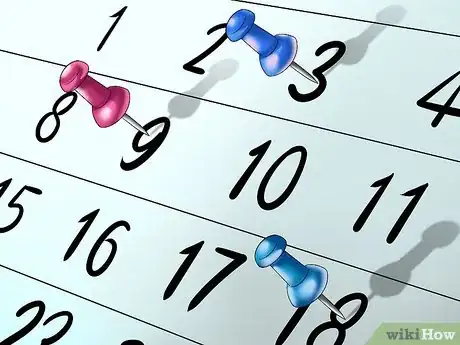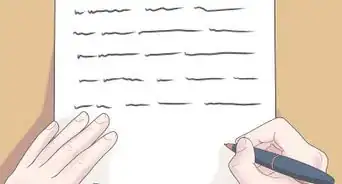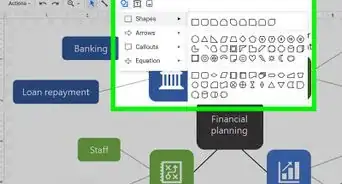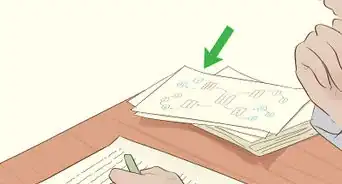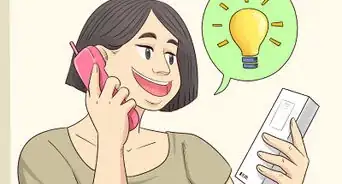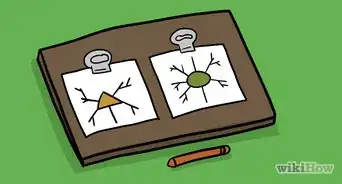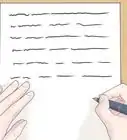This article was co-authored by Helena Ronis. Helena Ronis is Co-founder and CEO of AllFactors, a unified web analytics software to drive company's marketing and business growth. She has worked in product and marketing in the tech industry for over 8 years, and studied Digital Marketing & Analytics at the MIT Sloan School of Management Executive Program.
There are 22 references cited in this article, which can be found at the bottom of the page.
This article has been viewed 62,462 times.
Have you ever been stuck thinking of a topic for your new project? Or do you not know what the name of your next chapter in the book should be? Good ideas require hard work, some space to distance yourself from your preconceived notions, and a sounding board to test your ideas against.
Steps
Getting Your Brain Moving
-
1Immerse yourself in the subject. To get your brain on track to come up with an idea, you need to surround it with a lot of relevant information. What this means will depend upon what type of idea you are trying to come up with.
- If you are trying to come up with a theory, do a lot of relevant research. You should do studies that problematize your existing ideas. If you have gotten yourself to the point where you have so much information that you think that you know less about the subject than you did before, your brain will struggle to reconcile the facts with your theories even when you feel that you have turned it off.[1]
- If you are working on fiction, read a lot of other authors who are trying to do similar things. Read books that familiarize you with the setting of the place you are writing about. Read literary theory to give you some perspective on how to write. Read philosophy to get ideas you might want to tackle in your fiction.[2]
- If you are an artist, spend some time reviewing the works of other artists in similar fields.
-
2Get to know new and different people. Interacting with people outside of your normal social group will expose you to new ideas and perspectives. This is pivotal to developing “psychological distance,” which is one of the most important prerequisites to creativity.
- Psychological distance is when you begin to look at things from a perspective other than that which you are accustomed to. Once you begin putting yourself in the shoes of a different person, it is easier to approach your problems in a way you haven’t thought of before.[3]
Advertisement -
3Go someplace new. Traveling is also a good way to create “psychological distance.” Exposing yourself to new sights and sounds will cause you to think of things from a new perspective. Sometimes you can save yourself a plane ticket and use your imagination to turn the familiar into the unfamiliar.[4]
- Even imagining yourself in a new place can make you approach things from a new, more creative perspective.
- Similarly, people have been shown to be more creative when they imagine the problem they are dealing with to be happening in the distant future.
- Alternatively, practice mindfulness to begin looking at your own world in a new way. Focus on something specific in your environment and try to experience it in its entirety. Notice things that would pass you by in your everyday life.[5]
- One useful example of mindfulness is to pay close attention to crowded social environment. Go on a walk in an urban area or wait around in a crowded park. Look at how people interact with one another. Pay attention to their idiosyncrasies and imagine what is happening in their head. This will put you in another person’s shoes.[6]
-
4Get a pen and write. Allow your ideas to flow freely. You can focus on the topic that you are working on, but allow yourself to venture elsewhere if that is necessary to keep things flowing. Doing journal entries every day can be a good way to get you started writing. Even if the focus is on personal matters, you might wander into your creative work from a new perspective.[7]
-
5Keep a schedule. When no ideas are forthcoming, it can be easy to get discouraged and procrastinate. However, you typically won’t experience an epiphany until you’ve really struggled to work through your problems. Make self-imposed deadlines and force yourself to live up to them. If what you produce by the deadline isn’t spectacular, at least you know what hasn’t worked and how to improve in the future.[8]
-
6Perform structured brainstorming sessions. The demands of a rigorous, structured brainstorming session can force you to create more than you would otherwise. Set a time limit and goals that you aren't sure that you can meet. If you fail, you will still produce more than you would have if you hadn't challenged yourself.
- For example, give yourself 30 minutes to come up with 30 ideas. Just write as quickly as possible.
- Give yourself 30 minutes to write two pages of material.
- Alternatively, give yourself an hour to sketch out a drawing.
- It's unlikely that you'll come out with a great final product, but this sort of challenge can force you to come up with new ideas.[9]
-
7Learn what to forget. The main part of the creative process will always be excluding the things that don’t matter. Knowing what doesn’t matter at the beginning can be difficult — as creative types, we tend to want it all — but you should start writing down some ideas, even if they don’t seem well founded at first. Begin structuring the important information in your head and weed out what doesn’t seem to fit.[10]
Disengaging from Work
-
1Create the right conditions for epiphanies to occur. Epiphanies are rare and difficult to control, but they are often the most important and impactful ideas that we produce. Epiphanies are produced by our unconscious mind, struggling with ideas that have dominated our conscious mind. To have an epiphany, therefore, we need both to work strenuously with ideas, but also take time off periodically to let them percolate.[11]
- That doesn't mean that you should take off all the time. Try to give yourself at least an hour a day to let your mind wander naturally. Take at least a day off every week for the same purpose.
-
2Make yourself happy. We can get angry and frustrated when struggling to figure something out. Those feelings will interrupt our creative process. We need to take some time off to be happy. How we do that will vary with our individual tastes.[12]
- Try shopping. Check out some of the sights and sounds while you are out of the house.
- Surfing the web is a way to distract yourself that also exposes you to new ideas and information.[13]
-
3Enjoy nature. Go outside in your backyard and look at the sky. Go on a hike. Clear your mind. Try to focus on nature rather than the problems that you have been grappling with. Let your mind wander naturally and you might find what you are looking for.[14]
-
4
-
5Meditate. Meditation is the classic way to clear your mind. Once you’ve cleared your mind, some of the mental blocks and preconceived notions that are hindering your creativity will collapse.[17]
- Close your eyes and focus on one thing. It can be a phrase that you repeat in your head or a picture that you imagine in your mind’s eye. If your mind begins to stray elsewhere, gently pull it back to what you were meditating on.
- Mindful meditation has been shown to increase creativity by allowing the conscious part of your mind to take precedence over the reactive, habitual reptilian brain.[18] [19] To perform mindful meditation, sit upright in cross-legged pose, with few distractions. Devote about 25% of your attention to controlling and observing your breathing. Keep your eyes open and pay close attention to everything in your surroundings. When your mind begins to wander, focus it back on your environment.[20]
Testing Your Ideas
-
1Put your idea on paper. Once something has popped into your head, it is important to see if it works. Start mapping it out on paper, drawing it, or writing it down. Be sure that you have some record of what you have come up with so that you don’t forget it.[21]
- Consider keeping a notebook on hand so that you can write down your ideas before they slip away.
-
2Research your idea. An idea might seem good at first, but be unfounded. If it is an empirical theory, test it against the evidence to determine whether it is valid. If it is a literary or artistic idea, go back to the work of other artists to determine how original it is. See if your understanding of the setting or the facts of the plot are realistic.[22]
-
3See what the critics say. You should constantly seek feedback to improve your work. If you can get professional feedback that is great, but, if that is not feasible, start with your social circle. Throw your ideas out to your friends or significant other. Just because an idea sounds good to us doesn’t mean that it will fly with other people.[23]
Expert Q&A
-
QuestionHow can I come up with a good business idea?
 Helena RonisHelena Ronis is Co-founder and CEO of AllFactors, a unified web analytics software to drive company's marketing and business growth. She has worked in product and marketing in the tech industry for over 8 years, and studied Digital Marketing & Analytics at the MIT Sloan School of Management Executive Program.
Helena RonisHelena Ronis is Co-founder and CEO of AllFactors, a unified web analytics software to drive company's marketing and business growth. She has worked in product and marketing in the tech industry for over 8 years, and studied Digital Marketing & Analytics at the MIT Sloan School of Management Executive Program.
Business Advisor If you are looking for a new business idea, look at industries where there's a lack of competition or there's a gap in the market. If you can find a good opening in a market, this may be an opportunity to find a way to fill it!
If you are looking for a new business idea, look at industries where there's a lack of competition or there's a gap in the market. If you can find a good opening in a market, this may be an opportunity to find a way to fill it!
References
- ↑ https://libguides.mit.edu/select-topic
- ↑ https://libguides.usc.edu/writingguide/literaturereview
- ↑ https://www.scientificamerican.com/article/an-easy-way-to-increase-c/
- ↑ https://www.scientificamerican.com/article/an-easy-way-to-increase-c/
- ↑ https://www.apa.org/topics/mindfulness
- ↑ https://www.psychologytoday.com/us/basics/mindfulness
- ↑ https://slc.berkeley.edu/writing-worksheets-and-other-writing-resources/you-start-writing-paper
- ↑ https://www.psychologytoday.com/us/blog/anxiety-in-high-achievers/202107/5-ways-stop-procrastinating
- ↑ https://www.helpguide.org/articles/stress/surviving-tough-times.htm
- ↑ https://www.apa.org/ed/precollege/psn/2013/09/learning-secrets
- ↑ https://www.psychologytoday.com/us/blog/epiphany/201101/how-do-you-we-i-define-epiphany-exactly
- ↑ https://www.psychologytoday.com/us/blog/click-here-happiness/201801/how-be-happy-23-ways-be-happier
- ↑ https://www.helpguide.org/articles/stress/quick-stress-relief.htm
- ↑ https://www.psychologytoday.com/us/blog/the-athletes-way/201504/5-neuroscience-based-ways-clear-your-mind
- ↑ https://www.fnu.edu/benefits-studying-music/
- ↑ https://psychcentral.com/stress/the-power-of-music-to-reduce-stress
- ↑ https://www.helpguide.org/home-pages/audio-meditations.htm
- ↑ https://www.helpguide.org/harvard/benefits-of-mindfulness.htm
- ↑ https://www.ncbi.nlm.nih.gov/pmc/articles/PMC3887545/
- ↑ https://www.psychologytoday.com/blog/the-courage-be-present/201001/how-practice-mindfulness-meditation
- ↑ https://writing.wisc.edu/handbook/process/generatingideas/
- ↑ https://libguides.usc.edu/writingguide/outline
- ↑ https://ctb.ku.edu/en/table-of-contents/maintain/maintain-quality-performance/feedback-from-clients/main




